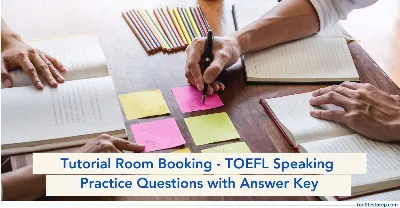Testing Center Rules - TOEFL Speaking Practice Test with Answers (Integrated)

"Prepare for the TOEFL Integrated Speaking section with a practice test on 'Testing Center Rules' and learn to improve score in TOEFL exam. "
Key Highlights
The Speaking Integrated Task represents a sophisticated assessment of English language proficiency within the TOEFL exam. It goes beyond basic speaking skills, requiring you to process and connect information from different sources while maintaining clear and organized expression.
This task evaluates your command of essential speaking components: pronunciation accuracy, speech fluency, vocabulary precision, and logical coherence. Our carefully crafted practice materials on "Testing Center Rules" are designed to strengthen these vital skills.
Time to begin your preparation journey! Let's work together to enhance your ability to handle this challenging yet rewarding section of the TOEFL exam.
Instructions:
- You will first read a short passage about a campus-related announcement or proposed change. You will have 45 seconds to read the passage.
- Then you will listen to a conversation between two speakers discussing their opinions about the announcement or change.
- After the conversation ends, you will be asked to respond to a question about what you read and heard.
- You will have 30 seconds to prepare your response.
- You will have 60 seconds to speak about the speaker's opinion and the reasons they give for holding that opinion.
Reading Time: 45 Seconds
The university has announced new rules for the testing center to ensure a fair testing environment.
Testing Center Rules
The university has implemented new rules for the testing center to maintain a fair and secure environment. Firstly, students must present a valid student ID before entering the testing area. Secondly, all electronic devices, including mobile phones and smartwatches, are strictly prohibited inside the testing room. Lastly, students are required to arrive at least 15 minutes before the scheduled exam time to avoid any disruptions. These measures aim to uphold academic integrity and ensure a smooth testing process for all students.
Directions: After the passage appears, a timer located at the top of your computer screen will commence counting down the time allocated for reading. Once the reading time concludes, the passage will disappear from the screen, replacing an image showing a student.

Now, listen to this Audio and answer the question that follows and answer the question that follows.
Audio Transcript
Speaker A: Did you hear about the new rules at the testing center?
Speaker B: Yes, I did. I think they're quite necessary. Presenting a student ID ensures that only registered students take the exams.
Speaker A: I see your point, but I find the rule about electronic devices a bit too strict. What if someone needs their phone for emergencies?
Speaker B: Well, I believe it's crucial to prevent cheating. Plus, they can always leave their phones with the staff outside the room.
Speaker A: True, but arriving 15 minutes early seems excessive. Some students have back-to-back classes and might struggle with this.
Speaker B: I understand, but it helps in starting exams on time and reduces last-minute chaos. It’s better for everyone in the long run.
Speaker A: I guess so, but I still think they should consider some flexibility for students with tight schedules.
Speaker B: Perhaps, but overall, these rules seem to prioritise fairness and integrity, which is essential in an academic setting.
Speaker A: I agree with the intention, but I hope they’ll review the rules if they cause too much inconvenience.
Speaker B: That’s a fair point. Maybe they’ll adjust them based on student feedback.
Directions: Once the lecture concludes, the picture of the two students will be replaced by a screen instructing you to prepare to answer the question. Subsequently, the following question will appear on the screen and will be read aloud by a narrator.
Question
State the speakers' opinions about the new testing center rules and explain their reasons for agreeing or disagreeing.
Preparation Time: 30 seconds
Response Time: 60 Seconds
Hold on to those answer sheets! Before you jump into the sample response, make sure to go through our top 7 Tips for TOEFL preparation.
Answer Key with Explanation for TOEFL Speaking Test - Testing Center Rules
We've provided two sample responses at different proficiency levels (mid-level and high-level). By comparing the differences, you'll gain valuable insights into the key elements that contribute to achieving a top score on the TOEFL exam.
Listen to the audio recording to hear a mid-level answer to the provided question.
Mid-Level Answer Audio Transcript:
Um, in the conversation, Speaker A and Speaker B talks about the new rules at the testing center. Speaker A, uh, thinks the rules are too strict, especially about electronic devices and arriving early. They say students might need phones for emergencies. Speaker B, um, supports the rules, saying it helps prevent cheating and maintain integrity. They suggest leaving phones with staff. Uh, Speaker A also mentions arriving early is hard for students with back-to-back classes. Speaker B thinks it reduces chaos. Speaker A hopes for flexibility. Speaker B, um, believes fairness is important. Overall, Speaker B supports the rules, while Speaker A is concerned about inconvenience.
Rater’s Comment:
The response earns a Score 1 due to significant language and delivery issues. Language errors include subject-verb agreement, as in "Speaker A and Speaker B talks," and tense inconsistency, such as "Speaker B, um, supports the rules." Filler words like "um," "uh," and "um" appear frequently, disrupting fluency and causing unnatural pauses. Speech clarity is compromised by these hesitations, making the delivery choppy. Content development is weak, with repeated ideas like "Speaker A hopes for flexibility" and missing support points, such as specific examples from the conversation. Transitions between ideas are weak, and the response lacks coherence. To score higher, the speaker should focus on reducing filler words, improving grammatical accuracy, and providing more detailed content with clear transitions. Practising structured responses could enhance coherence and fluency.
Listen to the audio recording to hear a high-level answer to the provided question.
High-Level Answer Audio Transcript:
In the conversation, Speaker A and Speaker B discuss the new testing center rules. Speaker A expresses concerns about the strictness of the rules, particularly the prohibition of electronic devices and the requirement to arrive 15 minutes early. They argue that students might need their phones for emergencies and that arriving early could be challenging for those with back-to-back classes. On the other hand, Speaker B supports the rules, emphasising the importance of maintaining academic integrity and preventing cheating. They suggest that leaving phones with staff is a reasonable solution and believe that arriving early helps in starting exams on time, reducing chaos. Speaker B acknowledges the need for fairness and integrity in an academic setting, while Speaker A hopes for flexibility if the rules prove inconvenient. Overall, Speaker B prioritises the benefits of the rules, whereas Speaker A is concerned about potential inconveniences.
Rater’s Comment:
This response earns a score of 4 due to its comprehensive coverage of the task, demonstrating a high level of language proficiency and effective topic development. The speaker employs advanced grammar structures, such as "Speaker A expresses concerns about the strictness of the rules," and uses sophisticated vocabulary like "prohibition" and "integrity." The response features complex sentence constructions, exemplified by "Speaker B acknowledges the need for fairness and integrity in an academic setting, while Speaker A hopes for flexibility if the rules prove inconvenient." The delivery is fluid, with a natural flow and smooth transitions, as seen in the seamless shift from discussing electronic devices to the early arrival requirement. The content is well-organised, with clear idea progression and coherent arguments, effectively contrasting Speaker A's concerns with Speaker B's support. These elements collectively demonstrate mastery, with notable strengths in language use and topic development to maintain.
Did you nail the practice test? Fantastic! Let's keep that momentum rolling. We offer a wealth of personalized practice tests specifically designed to address your weaknesses and boost your TOEFL Speaking skills.
The more you practice, the more confident you'll become!
Also Read:
Featured Articles

Marriage Across Cultures - TOEFL Reading Practice Test
Improve TOEFL Reading with passages on 'Marriage Across Cultures,' delving into unique traditions, values, and global perspectives on marriage.
July 15, 2025
Writing Center Services - TOEFL Speaking Practice Test with Answers (Integrated)
Prepare for the TOEFL Integrated Speaking section with a practice test on 'Writing Center Services' and learn to improve score in TOEFL exam.
July 15, 2025
Tutorial Room Booking - TOEFL Speaking Practice Test with Answers (Integrated)
Prepare for the TOEFL Integrated Speaking section with a practice test on 'Tutorial Room Booking ' and learn to improve score in TOEFL exam.
July 15, 2025
Textbook Rental System - TOEFL Speaking Practice Test with Answers (Integrated)
Prepare for the TOEFL Integrated Speaking section with a practice test on 'Textbook Rental System' and learn to improve score in TOEFL exam.
July 15, 2025